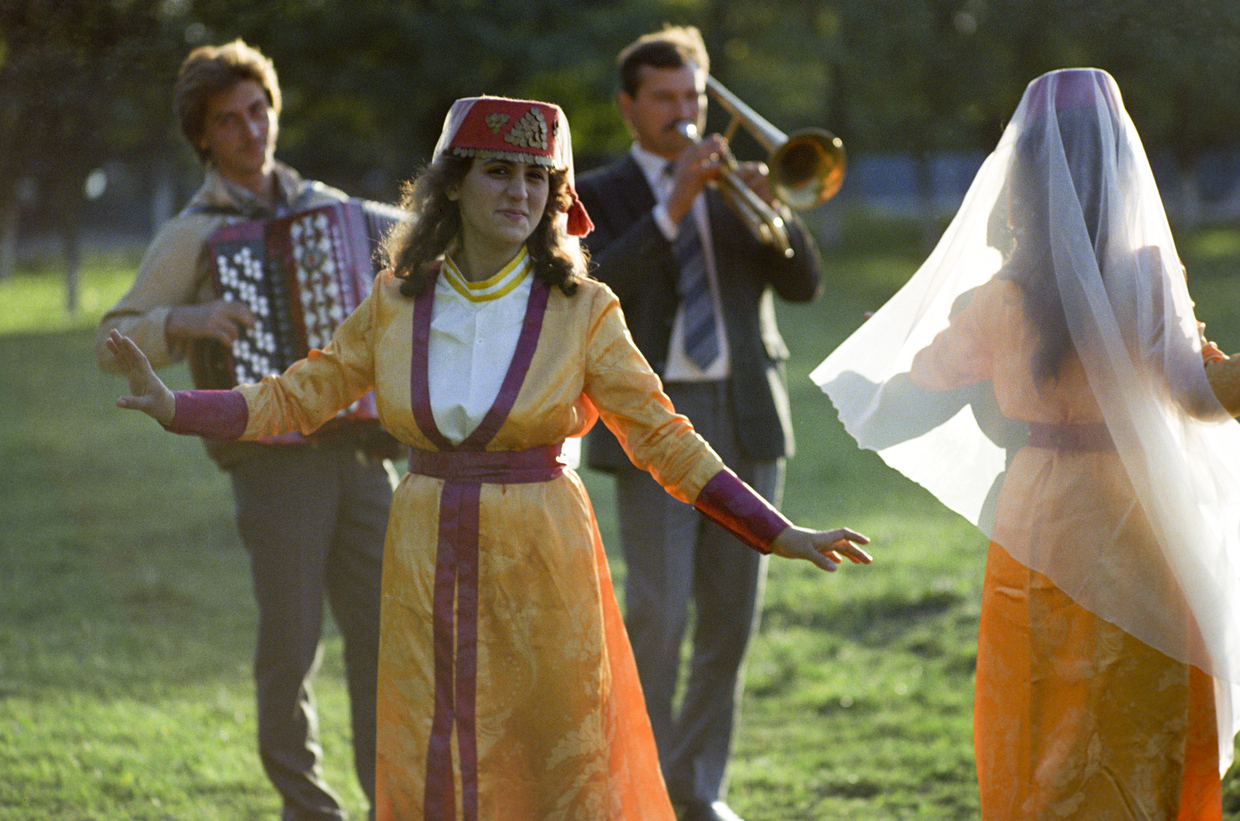From Stalin's wrath to Khrushchev's gift to Ukraine: Crimea's Tatar minority has faced death, misery and deportation

Crimean Tatars play an important role in the story of the peninsula's reabsorption by Russia. One of Ukraine's main propaganda tools is to accuse Russia of violating their rights. At the same time, Turkey is also a factor – through its cultural ties with what it sees as the "brotherly" Turkic people.
However, the Tatars themselves seem to be split into two camps after the events of 2014, when their home area returned to Moscow's control.
One of the main reasons why at least some Crimean Tatars seem to contest the legitimacy of the reunification goes back to the 1940s when, during the Soviet Union’s involvement in World War II, a decision was made by the Georgian-born Joseph Stalin to deport them to Central Asia by force. RT looks back at these tragic events.
Crimean Tatars: Who are They?
The formation of the Crimean Tatars as an ethic group occurred between the 13th and 17th centuries, uniting Cumans, also known as Polovtsy, a Turkic nomadic people who appeared in the area during the tenth century, with others who had inhabited the peninsula since ancient times and gradually underwent Tatarization.
Following the disintegration of the Mongolian Golden Horde, a large Chingisid-founded empire that at its peak extended from Siberia and Central Asia to parts of Eastern Europe, a number of smaller khanates were formed. The Crimeans frequently mounted raids into the Danubian principalities, Poland–Lithuania, and Muscovy to enslave people. This trade, as well as the ransom business, were the backbone of the khanate’s economy.
In the 18th century, after a series of successful anti-slavery and military campaigns, as well as through diplomacy, the Russian Empire incorporated Crimea. While some of the local upper class entered into an arrangement with the new rulers, others chose to leave the peninsula and join the Ottoman Empire across the sea.

After the formation of Soviet Union in 1921, the Crimean Autonomous Soviet Socialist Republic was created as part of the Russian Soviet Federative Socialist Republic.
Hitler’s Plans
Hitler had a special place for Crimea in his future plans for the Third Reich after the expected victory in World War Two. The peninsula was to be vacated of its current inhabitants for the arrival of an Aryan population. Despite the fact that this project wasn't implemented, Crimea remained under Nazi occupation for a sum total of almost two years, and that had been hard enough.
Nazis excelled in the art of ruling the occupied territories by actively applying the “divide and conquer” principle to the local ethnic groups and nations. Thus, they relied on Ukrainian collaborators to do all their dirty work in Belarus, and used Cossacks to crush the uprising in Warsaw in 1944. In Crimea, their allies were the so-called ‘Tatar national committees,’ organized by German intelligence organs in order to influence the local population, spread propaganda and recruit volunteers who were often used to infiltrate the rear of the Red Army with spies and saboteurs.
It can’t be said to have been exactly a win-win deal, though. Nazi Germany wasn’t really interested in supporting the hopes of Crimean Tatars to carve out an ethnic Crimean Tatar mini-state on the peninsula, and the German authorities on site made it abundantly clear.
Wehrmacht’s pawns
Thus, while some of the Crimean Tatar collaborators were used to infiltrate the rear of the Red Army and police the occupied territories, others were tasked with promoting the Nazi ideology. Some were so eager to oblige that they even filed proposals with their Nazi bosses to exterminate all Russians on the peninsula.

Red Army commanders and partisans kept records of all crimes committed by the Crimean Tatar collaborators against the civilian population and prisoners of war during the occupation. Sometimes the situation was so absurd that Germans had to intervene and protect the civilians and POWs from their overzealous helpers.
“On July 4, I was taken captive. We were escorted by some Tatar traitors. They kept beating the medics with clubs. After a while in a Sevastopol prison, we were forced to march through the Belbek Valley that had been mined. Many POWs from the Red Army and Navy were killed. Then they crammed us into tiny prison cells in Bakhchysarai. Three days later, we had to march to Simferopol. We were escorted by Germans and a number of Crimean Tatar traitors. I saw one Tatar cut off a seaman’s head,” a Red Fleet seaman, Yanchenko, described the cruelty of some Crimean Tatar collaborators in his letter dated 1942.
Most of them, however, were less bloodthirsty and chose to collaborate more for reasons of trying to survive and to obtain money and land deals under the Nazi rule.
By assessments, up to 20,000 Crimean Tatars could have been recruited in 1942 for prisoner control and counterinsurgency operations, as well as for other ‘volunteer’ jobs.
They were also a formidable force in the Crimean Mountains, as they knew the land very well, and many partisan detachments fighting on the Red Army’s side suffered at their hand.
Banished from Native Lands
The number of Crimean Tatars in the Red Army was only slightly larger than in the collaborationist detachments, and they were represented quite modestly in the partisan detachments in Crimea. However, in 1943, a mass desertion of collaborators began, as they switched to the side of the partisans.
Nevertheless, many stayed with Hitler until the end. Several battalions of collaborators were defeated in the spring of 1944. Those who managed to retreat with the Germans subsequently formed the Tatar Mountain Jaeger brigade of the SS.
In the spring of 1944, the Russians defeated the German 17th Army and liberated Crimea. At that point, the country’s leadership was faced with ‘the Tatar question.’ In May of 1944, another Georgian Lavrenty Beria – the chief of the USSR’s political police, the NKVD – reported to Stalin that more than 5,000 collaborators (not only Tatars) had been arrested in Crimea and about 6,000 firearms had been seized on the peninsula. Beria stressed that a “significant part” of the Tatar population had collaborated with the Nazis.

It was Beria who proposed evicting the Tatars from Crimea and sending them to Uzbekistan for use in agriculture. Literally the next day, on May 11, 1944, the USSR State Defense Committee adopted a resolution to forcibly evict the Tatars.
They were allowed to take personal belongings, clothes, household equipment and food with them, but their land, cattle, and other property were seized by the state.
NKVD units carried out the operation within three days. Some 180,000 people were loaded into 67 trains and sent to Central Asia. At the same time, the military seized about 12,000 more weapons, including mortar launchers and machine guns. Frontline soldiers who had taken part in the Crimean Soviet underground and their families managed to avoid deportation on request, as well as some women who had married men of other nationalities. However, these literally amounted to several hundred people.
The living conditions at the point of arrival were extremely difficult. Apart from natural mortality, modern researchers believe that at least 13% died in the fall of 1948. It is worth noting that a significant portion of these people fell victim to the last mass famine to afflict the USSR, which occurred immediately after the war. However, for the Crimean Tatars the situation was complicated by the seizure of their property, the difficult living conditions in the new place, and an unfamiliar climate. Although the authorities allocated building materials, land, and loans for construction, people were forced to settle in Uzbekistan essentially from scratch.
In the coming years, the Tatars were branded with the status of ‘special settlers,’ which included a significant loss of rights – most importantly, the right to leave their area of residence.

Exoneration and Return
The situation did not change for a long time, even after Stalin’s death. The turning point was the decree of the Presidium of the Supreme Soviet of the USSR ‘On Citizens of Tatar Nationality Who Previously Lived in Crimea.’ In particular, it stated:
“The facts attesting to the active cooperation with the German invaders of a certain part of the Tatars living in the Crimea were unreasonably attributed to the entire Tatar population of Crimea. These sweeping accusations against all citizens of Tatar nationality who lived in Crimea should be dropped, especially since a new generation of people has entered society’s workforce and political life.”
Then there was an instruction to cancel the orders containing accusations against the Tatars. However, legal nuances contained in the same decree, in fact, limited their ability to move back to Crimea.
The mass return began only in 1990, shortly before the collapse of the USSR. Since the Soviet Union was already in its death throes, and the Tatar question was a third-rate issue for the authorities of both Russia and Ukraine, a new problem arose when Tatars took it upon themselves to seize land plots on returning to Crimea. From their point of view, they were simply reappropriating what they had lost in 1944.
The Crimean Tatars are one of the numerous peoples whose fate took a dramatic turn in the 20th century. Again in the 1950s when Soviet leader Nikita Khrushchev, himself raised in Eastern Ukraine, handed over the territory to Kiev, apparently without consulting anyone. However, in the late USSR era, their situation stabilized and the fate of the Tatars generally coincided with that of the rest of Crimea’s inhabitants.
What about the Crimean Tatars now?
By the time, Crimea rejoined Russia the bulk of the peninsula’s population was made up of ethnic Russians (Russians living in Crimea, but not Russian citizens), whose mass rejection of the Western-backed Kiev 'Maidan' coup set the stage for its return "home."
Tatar activists were initially active on the side of Ukraine, and the first victims of clashes in Crimea were two Russians who died when pro-Moscow and pro-Kiev Tatar rallies collided.

As a result of the events of 2014, the Tatar community split. The pro-Ukrainian part is represented by the ‘Mejlis of the Crimean Tatar People,’ an organization that claims to represent the group. In fact, it is rather a virtual entity capable of fielding a total of several hundred activists, which is not even currently located in Crimea. Its attempt to form a combat wing in the form of a pro-Ukrainian volunteer battalion yielded zilch. In reality, the influence of the ‘Mejlis’ consists mainly in calling for the destruction of Crimea’s infrastructure, in particular, the bridge between the peninsula and the rest of Russia. The organization’s activities have been banned in the Russian Federation.
Moscow has learned from the mistakes of the Soviet Union and has demonstrated much more flexibility in its ethnic and language policies regarding Crimea than was seen back then. The ethnic-cultural autonomy of the Crimean Tatars is recognized within Russia, and the region’s official languages include Russian, Ukrainian, and Crimean Tatar.

















